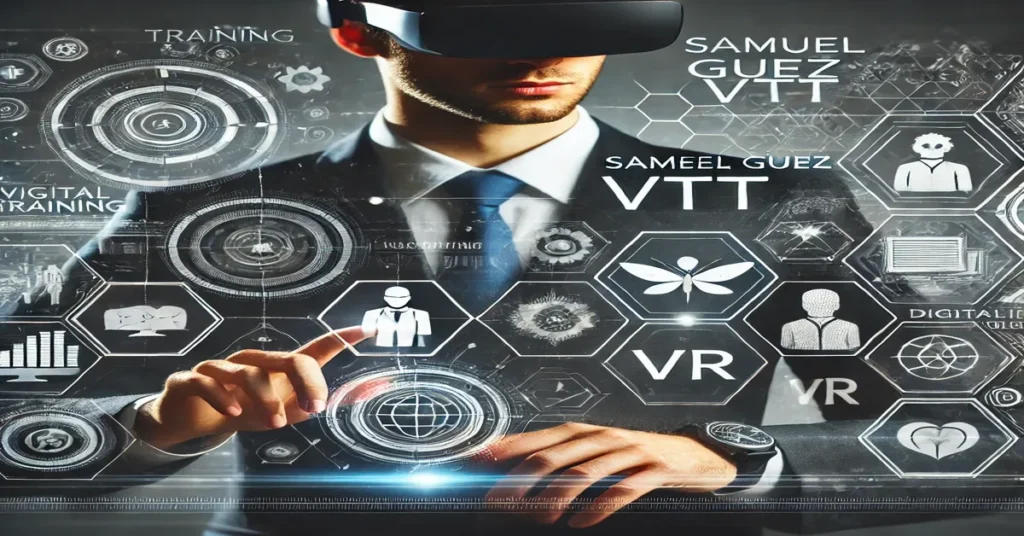In today’s fast-paced digital world the way we learn and train is constantly evolving. At the forefront of this transformation is Samuel Guez VTT, a notable figure in virtual training and digital innovation. With his extensive knowledge in technology-driven education, Samuel Guez VTT has been instrumental in developing effective training solutions that leverage virtual reality (VR), augmented reality (AR), and simulation tools. This article delves into Samuel Guez’s contributions to the field, the significance of his work, and the future of virtual training.
Who is Samuel Guez VTT?
Background and Expertise
Samuel Guez VTT is not just a name in the industry he is a visionary dedicated to reshaping how organizations approach training and development. With decades of experience, he has become a sought-after expert in creating immersive training environments that engage learners and improve retention.
His background spans various sectors, including corporate training, educational institutions, and technology development. Samuel Guez VTT passion for harnessing the power of technology in education has led him to explore innovative methods that challenge traditional training paradigms.
Contributions to Virtual Training
Guez has been involved in numerous projects that utilize cutting-edge technologies to enhance learning experiences. From designing training programs for multinational corporations to collaborating with educational institutions, his work emphasizes the importance of adaptability and engagement in training methodologies.
The Evolution of Training Techniques
Traditional vs. Modern Training Methods
Historically, training has relied heavily on conventional classroom settings and printed materials. While these methods served their purpose, they often fell short in terms of engagement and practical application. Samuel Guez recognized these limitations early on and began advocating for more dynamic and interactive approaches.
With the advent of digital technology, training has transitioned from passive learning to more interactive experiences. Virtual reality and augmented reality have opened up new avenues for immersive training, enabling learners to engage in realistic scenarios without the risks associated with real-world applications.
The Role of Technology in Training
Incorporating technology into training practices has revolutionized the industry. Tools such as VR and AR allow for the creation of realistic simulations that provide learners with hands-on experience. This technology-driven approach not only enhances engagement but also boosts knowledge retention.
Samuel Guez has played a pivotal role in promoting these technologies, demonstrating their potential to create meaningful learning experiences. By blending technology with education, he has helped organizations adapt to the ever-changing landscape of training needs.
The Impact of Samuel Guez’s Work
Enhancing Engagement and Retention
One of the most significant impacts of Guez’s contributions is the enhancement of learner engagement. Traditional training methods often result in passive learning, leading to lower retention rates. However, by utilizing immersive technologies, Guez has shown that learners can actively participate in their education, leading to improved outcomes.
Research indicates that immersive training experiences can significantly enhance knowledge retention. Learners are more likely to remember information when they can interact with it in a realistic context, making Guez’s approach particularly effective.
Developing Industry Standards
Samuel Guez’s work has also influenced industry standards in virtual training. His insights and innovative practices have guided organizations in adopting best practices for implementing technology-driven training solutions. By establishing benchmarks, Guez has helped ensure that virtual training programs deliver consistent and effective results.
Collaboration and Knowledge Sharing
In addition to his work in training design, Guez is committed to collaboration and knowledge sharing within the industry. He regularly participates in conferences, workshops, and seminars, where he shares his expertise and insights. This collaborative spirit has fostered a community of professionals dedicated to advancing virtual training.
The Future of Virtual Training
Trends Shaping the Landscape
As technology continues to advance, the future of virtual training looks promising. Key trends include:
- Increased Use of Artificial Intelligence: AI can personalize training experiences, adapting content to meet individual learner needs.
- Integration of Gamification: By incorporating game-like elements, training becomes more engaging and motivating for learners.
- Expansion of Remote Training Solutions: The rise of remote work has made virtual training solutions essential for organizations aiming to upskill their workforce.
Samuel Guez’s contributions position him as a leader in navigating these trends, ensuring that organizations remain at the forefront of training innovation.
The Importance of Lifelong Learning
In an era where change is constant, the concept of lifelong learning has gained prominence. Guez emphasizes that organizations must cultivate a culture of continuous learning to thrive. By embracing virtual training solutions, companies can equip their employees with the skills needed to adapt to evolving market demands.
Practical Applications of Virtual Training
Corporate Training Programs
Many organizations have successfully integrated virtual training into their corporate training programs. Guez’s methodologies have been particularly beneficial in sectors such as healthcare, manufacturing, and aviation, where practical skills are crucial.
For example, in healthcare, virtual simulations allow medical professionals to practice procedures in a risk-free environment. This hands-on experience enhances their skills and boosts confidence, ultimately improving patient care.
Educational Institutions
Guez’s influence extends to educational institutions as well. Schools and universities are increasingly adopting virtual training techniques to enhance student engagement and learning outcomes. By incorporating VR and AR into the curriculum, educators can create immersive learning experiences that captivate students’ attention.
In fields such as engineering and architecture, virtual training enables students to visualize complex concepts and apply theoretical knowledge in practical scenarios.
Skills Development for Remote Work
With the rise of remote work, virtual training solutions have become essential for skills development. Samuel Guez advocates for the use of technology to bridge the gap between remote learning and effective training. By utilizing virtual platforms, organizations can provide employees with the necessary tools to succeed in a remote work environment.
Challenges and Considerations
Resistance to Change
Despite the numerous benefits of virtual training, some organizations face resistance to adopting new methods. Employees may be hesitant to embrace technology, especially if they are accustomed to traditional training practices. Samuel Guez emphasizes the importance of addressing these concerns through effective change management strategies.
Ensuring Accessibility
Another challenge is ensuring that virtual training solutions are accessible to all learners. Guez advocates for inclusive design principles that accommodate diverse learning needs. By prioritizing accessibility, organizations can create training programs that are effective for everyone.
Balancing Technology and Human Interaction
While technology plays a vital role in modern training, Guez believes that human interaction remains essential. Combining virtual training with opportunities for collaboration and mentorship can enhance the learning experience and foster a sense of community among learners.
Conclusion
Samuel Guez VTT has made significant contributions to the field of virtual training and digital transformation. His work emphasizes the importance of adapting to technological advancements to create engaging and effective training solutions. By harnessing the power of VR, AR, and simulation tools, organizations can enhance learner engagement and retention, preparing their workforce for the challenges of tomorrow.
As the landscape of training continues to evolve, Samuel Guez VTT insights and expertise will undoubtedly shape the future of virtual training, making it an indispensable component of organizational success.
FAQs
- Who is Samuel Guez?
Samuel Guez is a leader in virtual training and digital transformation, known for his innovative approaches to technology-driven education. - What technologies does Samuel Guez use in training?
He utilizes virtual reality, augmented reality, and simulation tools to create immersive and effective training experiences. - How does virtual training improve learning outcomes?
Virtual training enhances engagement and retention by providing realistic scenarios for learners to practice and apply their skills. - What challenges does virtual training face?
Challenges include resistance to change, ensuring accessibility, and balancing technology with human interaction.







